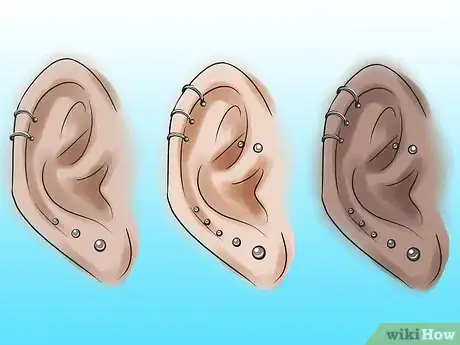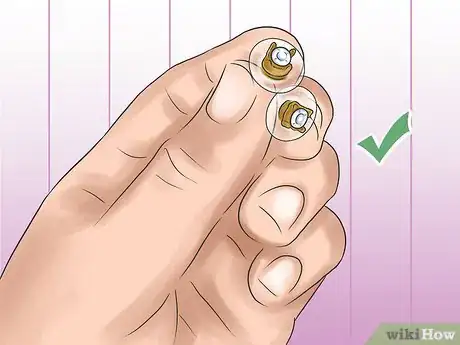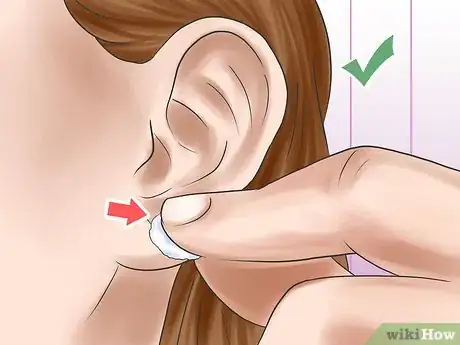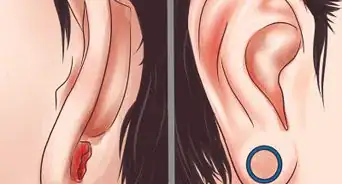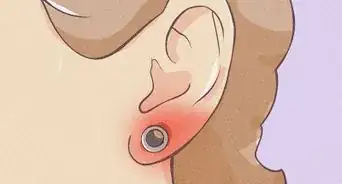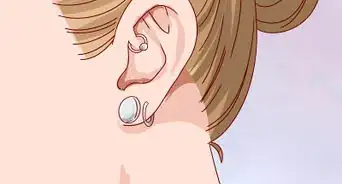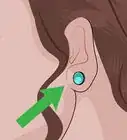This article was co-authored by Roger Rodriguez. Roger Rodriguez, also known as Roger Rabb!t, is the Owner of Ancient Adornments Body Piercing, a piercing studio based in the Los Angeles, California area. With over 25 years of piercing experience, Roger has become the co-owner of several piercing studios such as ENVY Body Piercing and Rebel Rebel Ear Piercing and teaches the craft of body piercing at Ancient Adornments. He is a member of the Association of Professional Piercers (APP).
There are 10 references cited in this article, which can be found at the bottom of the page.
wikiHow marks an article as reader-approved once it receives enough positive feedback. In this case, 94% of readers who voted found the article helpful, earning it our reader-approved status.
This article has been viewed 132,583 times.
Getting your ears pierced can be a big decision. There are several things to consider before choosing whether to adorn your ears. Knowing what to expect and the various factors to weigh will help you make an informed decision that you will be happy with.
Things You Should Know
- Before you make your decision, reflect on your age, the cost of piercing, and the pain factor.
- Think through whether or not your parents, your school, or your job may have an issue with your piercing.
- After deciding on a location and style for your piercing, head to mall or tattoo parlor to get your ears pierced.
Steps
Deciding Whether or Not You're Ready
-
1Consider your age. There is no legal age restriction on when you can get your ears pierced, but you will need signed consent from a parent if you are under the age of sixteen. The average age that people get their ears pierced is seven, but it ranges from infant to adulthood.[1]
- If you are in school it is important to consider your school’s rules on body piercings. If they are not allowed, you might want to wait to get them pierced.[2]
- A good indicator of whether you are old enough to get your ears pierced is if you can take care of pierced ears.
-
2Think about the cost. Getting your ears pierced involves two costs: the cost of the piercing and the cost of the jewelry. You will need to pay the piercer for their time and materials, and pay for the earrings you will have pierced. Sometimes you can bring your own earrings, but that is uncommon. Make sure you have the money together before you commit to getting your ears pierced.[3]
- The cost will range depending on where you go. If you go to a mall shop (like Claire’s) you will pay less than if you go to a piercing salon. A salon will likely be more sterile and have more jewelry to choose from.[4]
- The average cost of an earlobe piercing is between $20 and $55, depending on the jewelry.[5]
Advertisement -
3Learn about the possible pain. Getting your ears pierced is not a very painful process, but it does sting for a few seconds. Spend some time considering whether you feel you have the proper pain tolerance for a piercing. Most piercers will apply numbing agents to your ears before they pierce them to dull the pain. Some types of ear piercings hurt more than others. The typical earlobe piercing is the least of the painful piercings.[6]
- Sometimes you can expect swelling and redness after the piercing. These can cause irritation and pain if you touch your ears too much.[7]
Considering Outside Factors
-
1Consider medical reasons that may make piercing risky. There are some conditions that might hinder you from getting your ears pierced, or make it an uncomfortable process. Talk to your doctor before making a final decision to make sure it is a safe move.
- If you get rashes or lesions on your ears, you might want to avoid piercing them.
- If you have an autoimmune disorder that can interrupt the healing process, you might want to avoid piercing them.
- If you have allergies to jewelry or metals, you might want to avoid piercing them.
-
2Think about work and school. Do you have a job? Is there a dress code at your school? Some employers may prohibit certain types of piercings. While regular pierced ears are probably fine, cartilage piercings, multiple ear piercings, or other unconventional piercings may be prohibited by your place of work or school.
- Look over your school's dress code. It's probably in a handbook given to you at the beginning of the year regarding school rules. You can also ask a teacher or administrator at your school for a copy of your dress code if you cannot locate one. See if any types of piercings are prohibited by your school.
- If you have a part time job, ask your boss about the policy regarding piercings. If your place of employment bans certain types of ear piercings, it's a bad idea to get your ears pierced in those fashions.
-
3Talk to your parents. Your parents should be consulted if you're considering getting your ears pierced. They may have rules regarding wearing jewelry at home, and may also want you to wait until a certain age to get your ears pierced.
- Pick a quiet setting to talk to your parents, like your living room after school. Make sure you choose a time free of outside constraints, like extracurriculars and work.
- Calmly explain to your parents why you want to get your ears pierced. Let them know you've looked into the cost and understand the recovery period.
- If your parents say, "No," accept this for now. Complaining may frustrate your parents more. You may want to accept the answer and then ask for permission again in a few months or in a year. Your parents may be more willing to allow you to pierce your ears if you're older.
Deciding How to Get Pierced
-
1Consider different types of lobe piercings. Most people get their earlobes pierced, which is the most widely accepted mode of ear piercing. It will be considered appropriate at most schools and places of employment. The jewelry is pierced through the loose section at the front of the ear just above the earlobe. People will often put studs or hoops in this piercing.[8]
- You can get multiple holes in your ear lobe as well, allowing you to display many different earrings at once.
EXPERT TIPThere are a lot of different placements you can choose for ear piercings, depending on the aesthetic you want.
Roger Rodriguez, also known as Roger Rabb!t, is the Owner of Ancient Adornments Body Piercing, a piercing studio based in the Los Angeles, California area. With over 25 years of piercing experience, Roger has become the co-owner of several piercing studios such as ENVY Body Piercing and Rebel Rebel Ear Piercing and teaches the craft of body piercing at Ancient Adornments. He is a member of the Association of Professional Piercers (APP).
Roger Rodriguez
Piercing Specialist Roger Rodriguez
Roger Rodriguez
Piercing Specialist -
2Look into cartilage piercings. You can also pierce the cartilage on your ear. This is the stiffer area that surrounds your ear. Cartilage piercings are less common, but many people prefer the look. Keep in mind piercing cartilage is more painful than fleshy areas like the earlobe. There are many phone apps you can download that allow you to upload a picture of yourself and then preview several piercings using that picture. Consider using an app like this to better visualize a potential piercing if you're going a non-conventional route.
- The rook is pierced through the fold of cartilage in your ear just above the opening to the ear hole. It is often pierced with a barbell or sometimes a stud.
- Industrial and orbital piercings are pierced through the outer, top cartilage of your ear. The industrial is usually one piercing using two holes. The orbital is usually more than one piercing side-by-side (small hoops or studs).
- The helix is pierced through the outer cartilage on the outside edge of your ear. There are a lot of different ways this piercing can be done. Some will have several holes using one piece of jewelry. Some have several pieces of jewelry side-by-side.
- The forward helix is pierced through the outer front cartilage of the ear. People will usually put a small hoop or stud in this piercing.
-
3Decide where to get pierced. There are two main methods of piercings ears, using a spring-loaded piercing gun or a sterilized needle. Most “mall shops” use piercing guns, which pierce the ear by shooting the earring through the ear. Most piercing salons use hollowed sterilized needles. Tattoo parlors also use sterilized needles, but there may be specific age requirements for getting a piercing done at a tattoo parlor in some states. They pierce by removing the flesh when inserted into the target spot on the ear. They then place the earring into the hole.
- If you go to a mall shop, you will likely pay less. You may not get the same standards of sterilization that you will get at a piercing salon.
- Research options before making a decision. Make sure the place you go to has good reviews. If the procedure is not sterile you can risk infection.
- Do not be afraid to ask the piercer about their training and how long they have been piercing ears. Most of them are happy to provide this information.
- Some dermatologists and pediatricians will pierce ears for children. Ask yours if that is an option as well.[9]
-
4Choose your jewelry. There are a lot of options when it comes to the jewelry you can get for your piercing. You can choose simple studs or small hoops. Consider that your first set of jewelry should be easy to clean around, so do not choose anything too crazy.[10]
- The type of metal you get is important. You want to get implant grade stainless steel, gold, or titanium. These metals are hypoallergenic and will not irritate your skin while you are healing.[11]
- Make sure the end of the piercing post is small and has a fine point so it glides through the hole.
EXPERT TIPAvoid going to a studio that tries to sell you jewelry made of silver, or anything plated or coated, as those will break down over time.
Roger Rodriguez, also known as Roger Rabb!t, is the Owner of Ancient Adornments Body Piercing, a piercing studio based in the Los Angeles, California area. With over 25 years of piercing experience, Roger has become the co-owner of several piercing studios such as ENVY Body Piercing and Rebel Rebel Ear Piercing and teaches the craft of body piercing at Ancient Adornments. He is a member of the Association of Professional Piercers (APP).
Roger Rodriguez
Piercing Specialist Roger Rodriguez
Roger Rodriguez
Piercing Specialist -
5Care for your piercing. Getting your ears pierced leaves them vulnerable to infection, so make sure you care for them after the piercing. The average healing time for pierced ears is four to six weeks.[12] The aftercare process does not take much time but does require consistency. Your piercer should provide you with detailed aftercare instructions.
- Keep the pierced earrings in your ears until your holes are healed. Only then can you change your earrings to another set of earrings.[13]
- Always wash your hands before touching or cleaning your piercing. Be sure to remove any dried crusted material that has accumulated around the piercing. [14]
- Apply mild soap or saline to the piercing with a cotton ball. Rinse and dry the area. Do this twice a day during the healing process.[15]
- If you have aftercare solution, you can use that instead of soap.
Community Q&A
-
QuestionDoes ear piercing hurt?
 Community AnswerNot much, for most people. It feels like a sharp pinch, but after a few seconds the pain eases off.
Community AnswerNot much, for most people. It feels like a sharp pinch, but after a few seconds the pain eases off. -
QuestionAfter my ear piercings heal, do I have to wash my hands before touching or changing my earrings?
 さいちょうCommunity AnswerIt's not a must, but it is recommended to wash your hands before touching or changing earrings to avoid bacteria and getting an infection.
さいちょうCommunity AnswerIt's not a must, but it is recommended to wash your hands before touching or changing earrings to avoid bacteria and getting an infection. -
QuestionIs it painful to sleep with studs?
 Community AnswerSleeping with studs in can be painful, but is a very minor pain. If you are sleeping with studs, try not to put too much pressure on your ears.
Community AnswerSleeping with studs in can be painful, but is a very minor pain. If you are sleeping with studs, try not to put too much pressure on your ears.
Warnings
- Not taking care of your ears can cause infection.⧼thumbs_response⧽
- Do not use antibacterial ointment or hydrogen peroxide on your piercing. They will prevent the piercing from healing.[16]⧼thumbs_response⧽
- Do not swim in public pools or Jacuzzis until your piercing heals, to avoid infection. [17]⧼thumbs_response⧽
References
- ↑ http://www.goodtoknow.co.uk/family/542530/what-age-should-children-have-their-ears-pierced
- ↑ http://www.huffingtonpost.co.uk/2014/08/21/ear-piercing-for-children-when-is-the-right-age_n_7326496.html
- ↑ http://youngwomenshealth.org/2013/08/07/body-piercing/
- ↑ http://www.5minutesformom.com/105853/where-should-you-get-your-ears-pierced/
- ↑ http://health.costhelper.com/body-piercing.html
- ↑ http://wonderopolis.org/wonder/does-it-hurt-to-get-your-ears-pierced
- ↑ http://youngwomenshealth.org/2013/08/07/body-piercing/
- ↑ http://www.piercedhearts.biz/piercing-types/
- ↑ http://www.parents.com/health/ear-infection/ear-piercing-for-kids/
- ↑ http://intothegloss.com/2013/01/guide-to-piercing/
- ↑ http://youngwomenshealth.org/2013/08/07/body-piercing/
- ↑ http://youngwomenshealth.org/2013/08/07/body-piercing/
- ↑ http://wonderopolis.org/wonder/does-it-hurt-to-get-your-ears-pierced
- ↑ http://www.pamf.org/preteen/mybody/bodyscience/pt/piercings.html#What can I wear in my new piercing?
- ↑ http://www.parents.com/health/ear-infection/ear-piercing-for-kids/
- ↑ http://youngwomenshealth.org/2013/08/07/body-piercing/
- ↑ http://www.pamf.org/preteen/mybody/bodyscience/pt/piercings.html#What can I wear in my new piercing?







